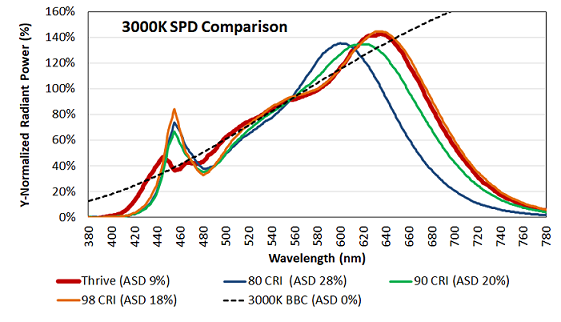‘Naturalness’ of artificial light
The Average Spectral Difference measure has been developed to enable the objective comparison of naturalness between different light sources.
US LED giant Bridgelux – which created the measure – says a new numbering system is needed to address the growing market interest in human-centric lighting where the question of naturalness of light source spectra is becoming a frequently asked question.
‘Standard lighting quality metrics such as the colour rendering index (CRI) and the colour metric TM-30 do not fully address the naturalness question’, said Bridgelux.
It said the ASD metric would deal with this shortcoming in available light quality metrics.
‘Unlike CRI and TM-30, where higher values indicate higher quality light, ASD represents the difference in spectra compared to natural light, therefore the lower the ASD value, the closer the match to natural light.
‘Throughout evolution, the human visual system has evolved under the natural light of sun and fire,’ said Bridgelux in a statement.
‘These light sources have standardised industry spectral power definitions that describe the state of natural light.
‘Lighting specifiers, designers, and luminaire manufacturers regularly consider colour quality metrics such as CRI and TM-30, as well as individual spectral power distributions (SPDs), when making decisions regarding light source selection.
‘However, until now, there has been no metric that quantifies the naturalness of a light source.
‘ASD provides an objective measurement of how closely a light source matches natural light over the visible spectrum, averaging the differences of the spectral peaks and valleys between a light source and a standardised natural light source of the same CCT.
‘The ASD value is a quantitative metric of the SPD differences shown in the figure below’.

‘The market is evolving to human-centric lighting,’ Brian Cumpston, vice president of solutions development at Bridgelux, told Lux.
‘While there are several approaches to developing human-centric lighting solutions, delivering the closest match to natural light is of great interest to our customers.
‘We hope this new metric will be broadly adopted in the lighting industry to provide new insight into naturalness beyond CRI and TM-30.’
Sources: www.bridgelux.com, www.luxreview.com